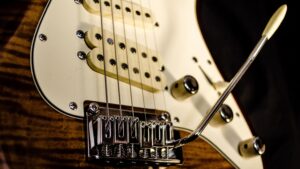
Guitar Prices Vary A Lot. Why is this?
When I was just 15 years old I decided that I was going to consolidate my lawn mowing money and buy my first electric guitar. I had a friend who all the kids liked because he owned the only drum set in the neighborhood. He loaned me a copy of a monthly catalogue he subscribed to called “Musicians Friend.”
I perused the catalogue setting out to find my dream axe. I had heard by word of mouth that the big boys used name brands such as Gibson, Fender, Jackson, and Ibanez. I was excited to see all these brands featured in Musicians Friend. I was even more excited to discover budget priced guitars made by some of these big companies. For example, Epiphones were still made by the reputable Gibson, and yet were way less expensive. Squire was owned by Fender, but the prices were within my reach.
But even within these “budget” divisions I noticed that there were still large variations in price. I remember seeing two different Epiphone Les Pauls. and both looked identical to the guitar that Slash played in the “Sweet Child of Mine” video. But while one was priced at around 300$, the other was priced at just over 100$. What exactly was I giving up if I were to purchase the one that was 100$. I almost had enough money to buy it but was there a reason for the low price? Would I regret buying it later?
While the pickups and electronics could definitely be a factor, I noticed another important trend. Guitars that were made out of certain wood types seemed to be more expensive. So what affect did the wood type have then? I would have loved to have better access to this information, because it’s definitely important to consider. Having said this, let’s look at some of the properties of typical guitar woods, also known as “Tonewoods.”
Guitar Tonewood Hardness, Highest to lowest
Let’s start off by learning about hardness. Why should you care about hardness? Well, for starters, you are going to find that guitars made of harder woods are more are generally more expensive and considered more “Elite.” This explains a lot of the price differences you see between seemingly similar models. Also, this information is easy to digest because you can rate hardness based on a number. This number is called the Janka Hardness Rating.
Let’s look at the common tonewoods, ranked from hardest to softest, according to their Janka rating:
Ebony 3220
Rosewood 1780
Maple 1450
Ash 1320
Mahogany 900
Alder 590
Poplar 540
Basswood 410
In case you are wondering, the Janka rating is the force (in Ft-Lbs.) required to imbed a .444-inch steel ball into a piece of wood until the ball has been imbedded by half its diameter. This is an official method commonly used in the flooring and lumber industry. But the important point to remember is that the higher the number is, the harder the wood.
So, why is harder wood more expensive? There must be advantages to harder woods, right? Yes, there are at least two qualities that improve as hardness increases. One is that hardness improves durability and holds up to wear over extended use. Another thing to consider is that the harder, more expensive woods tend to have more aesthetically pleasing wood grains.
Are there any disadvantages to harder woods? Again, the answer is yes. Other than the cost, one disadvantage is weight. For most of the common tonewoods, a greater hardness will usually mean a higher weight, which can be a disadvantage for someone who is playing a long gig. Having a heavy instrument could tire you out quicker.
So, after considering wood hardness, lets summarize how it could affect you.
ADVANTAGES OF HARDER TONEWOODS
- Woodgrain aesthetics improve as tonewood hardness increases
- The instrument will exhibit less wear or damage as tonewood hardness increases
DISADVANTAGES OF HARDER TONEWOODS
- Weight increases as tonewood hardness increases
So for a higher price you can get aesthetics and durability, which are great qualities if you don’t mind the guitar being a little heavier.
Guitars Can Be Made of Several Woods
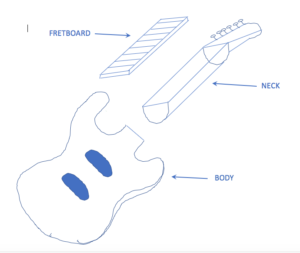
Usually a guitar is built with more than one type of wood. Its main structure consists of the body, the neck, and the fretboard. Each of these will likely be a different wood type.
One example would be a classic Fender Stratocaster made of an Ash body, a Maple neck, and a Rosewood fretboard. This would probably be a good sounding guitar if it had good electronics and was set up correctly.
Another example might be a Fender Stratocaster with an Alder body, Maple neck and Maple fretboard. This guitar would also be considered as highly regarded. There are a lot of different combinations of woods that might make for an excellent sounding instrument.
Another example would be another classic, a Gibson Les Paul. The most common and sought after Les Pauls are made of Mahogany, Maple, and Rosewood. But the body of the Les Paul usually consists of two different pieces: the base and the top. The most common example would be a Les Paul with a body consisting of a Mahogany base and a Maple top. The neck of a Les Paul is usually made of Mahogany, and its fretboard is typically Rosewood. History has proven this to be a super combination. Think Slash, Jimmy Page, Joe Perry, and many other rock icons.
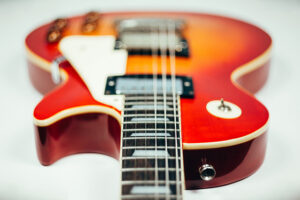
From the side view of this Les Paul you can see that most of the body is made up of the maroon colored bottom section. You can see the thickness of the Maple top represented by the outer white color color of the top section.
But a Les Paul doesn’t have to be made of this exact combination of woods. There are also Classic Les Pauls with pure Mahogany bodies that are great, depending on the sound you want. Again, companies will usually experiment with many different designs. This gives musicians more options and personalization.
Open Grain Vs Tight Grain In Tonewoods
Earlier in this article wood hardness was mentioned as a characteristic that tended to relate to their cost. Now let’s dive into the characteristic of wood that is most responsible for its tonal personality: grain tightness.
The general rule is that woods with a tight grain have a more pronounced initial attack, while woods with open grains have more resonance and sustain, since the sound has more space to reverberate.
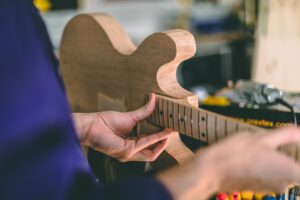
Let’s look at tonal characteristics of different Body and Neck tonewoods:
Alder:
Wood: Tight Grain.
Tone: Good balance of low, mid, and high frequencies.
Ash:
Wood: Open
Tone: Resonant with high sustain. A lot of treble but slightly reduced midrange
Basswood:
Wood: Tight grain
Tone: Balanced and warm, or lacking character depending on who you ask. Similar to Alder Highs and lows are slightly less pronounced. Budget wood but some pros swear by it.
Mahogany:
Wood: Open grain
Tone: Warm mellow tone. Lows and lower midrange are especially strong, upper frequencies are subdued. It is punchy but not especially crisp. Great sustain
Maple:
Wood: Tight Grain
Tone: Bright with quick attack, Upper midrange and high frequencies are especially pronounced. Excellent clarity. Good Sustain
Korina: (Found in Gibson Flying Vs and Explorers)
Wood: Open Grain (similar to mahogany)
Tone: Warm, mellow tone like Mahogany but midrange is more pronounced.
Poplar:
Wood: Tight Grain
Tone: Even balance of low, midrange, and high frequencies
Fretboard wood
Hardness comes into play when talking about fretboard wood. This is the wood that takes the brunt of the wear. If you think about it, a guitarist can spend hours pushing a metal string into a fretboard while bending notes. When he does this, he is basically pushing a piece of metal onto something and mashing it back and forth.
A wood that is made for this better be pretty resistant. For this reason, fretboard woods typically have a high hardness.
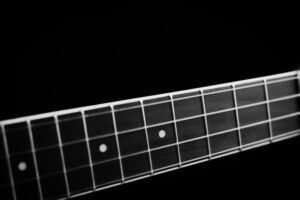
Rosewood:
Hardness: Very hard and durable doesn’t wear out.
Tonal Effects: Smoothens out sound
Ebony:
Hardness: Even harder than Rosewood. Wears out even less
Tonal Effects: Brightens and tightens sound.
Maple:
Hardness: Not as hard as Ebody or Rosewood, but still hard enough to be a fretboard wood. Can show wear over many years of use, revealing marks that some connoisseurs pride themselves in, as evidence of a well-used instrument.
Tonal Effects: Adds brightness, clarity, and attack.
Pau Ferro:
Hardness: Similar to Rosewood
Tonal Effects: Similar to Rosewood but slightly brighter
So, you can see that guitar wood grain has an effect on tone, especially for the body and neck which are the larger components. While hardness is very important to fretboard wood to reduce wear.
In terms of overall sound, the tonewoods do not have as much affect for electric guitars as they do for acoustic guitars. In acoustic guitars, all the sound comes from the wood.
But for electrics, most of the sound comes from the electrical signal. In an acoustic guitar, you hear sounds echoing directly from the hollow wooden body. With an electric however, the pickup receives vibrations that are mostly from the strings, and the wood resonance only makes a small difference. Many even argue whether an electric guitar’s wood makes any contribution at all. Others claim that there definitely is a difference.
The Science vs Art Debate: Does Tonewood Make a Difference in Electric Guitars?
This is typically a science vs art argument. The science argument usually doesn’t believe that the wood type on an electric guitar can have any effect on tone. The argument goes something like this: The sound you hear is produced by metal strings vibrating next to a pickup coil. This produces electrical current, which is sent through a conduit to the amplifier. The current is amplified and converted back into sound energy though the speaker (as a builder of DIY sound equipment, I can verify that this is all accurate.)
So, the scientific skeptic would say that since the current can be traced from the source (vibrating string), to the output (the speaker), then the guitar wood characteristics have nothing to do with the sound.
But then there is the musician’s perspective: Imagine the guy that has a very perceptive ear. He can do a blind sound test and tells you which guitar was used. He has been playing for years and is unwavering in his guitar preferences because there is an obvious difference. You will never convince him that wood makes no difference. How can this be?
Personally, I believe that tonewood does make a small difference in the tone of an electric guitar, but I don’t think that the difference is incredibly prominant. I base this opinion on experience, but also on a little science as well.
My theory is this: Pluck any string on an electric guitar and you will feel vibrations both in the guitar body and neck. Therefore, a certain amount of the string’s vibrational energy has been transferred (and lost) through the body and will not make it through the pickup coils.
The second part of my theory goes like this: A guitar construction is such that the strings rest upon the bridge and the nut (which are directly attached to the body and neck respectively). The strings will cause vibration in the body and neck, but the body and neck will also send their vibrations back to the strings. As Newton said, every action has an equal and opposite reaction. The vibration that the body sends back to the strings will have an effect on total string vibration that goes through the electrical pickup coils.
Imagine that the body and neck woods are both highly resonant. String vibration would keep these woods resonating, which in turn would keep the strings vibrating, which would again keep the woods resonating and so on. A highly resonant wood would continue this cycle and have a slow decay rate. This slower decay is also known as sustain.
So, Does Wood Type for Electric Guitars Matter?
I know that was some pretty deep stuff. But there is a point to all this. The conclusion is that knowing about the properties of an electric guitar’s wood might explain tonal nuances. But it will not likely be the most prominent component of your sound. Things that have more noticeable impact on your sound include pickup type, pickup position, the amplifier you use, and above of all the way you play.
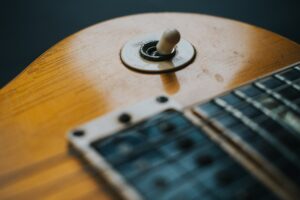
If you want to choose a guitar’s wood type based off of more concrete reasons, you might want to focus more on things related to hardness. Remember the important factors here: A higher price guitar usually means harder woods, which means more durability and prettier wood grain. Just be mindful of the weight.
If you want a lighter, more inexpensive guitar that still sounds great, I have good news: you can definitely find one! But if you want a guitar that looks and feels exactly like the one Jimmy Page played, well you can do that too. Finally, if you believe in a wood’s effect on tonal qualities, well take that into consideration as well. At the end of the day It is all about your needs and your preference. And I hope this article on tonewoods has cleared some things up.
I look forward to your comments,
Nathan
Sign up Below To Be A Part of The Connoisseur Community!
Don't worry, I am a minimalist and will only send occasional Emails when I have something important or very valuable to share. And it is a good idea to stay connected to valuable sources! Sign Up Below !!
[sibwp_form id=2]

Great looking web site. Think you did a great deal of your own coding.